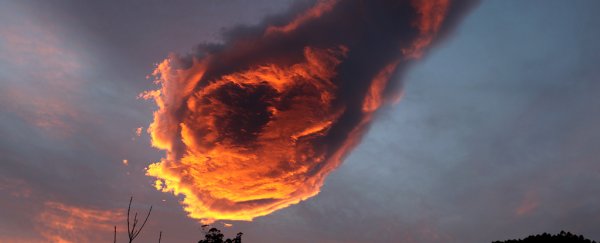At the start of last week, this incredible gold-tinged cloud descended from the sky over the Portuguese island of Madeira.
It was captured by photographer and weather blogger, Rogerio Pacheco, who described the cloud over on his blog as "a fireball" (according to the comments, it looked more like the "hand of God"). It's not quite as dramatic as that, but the simple science behind the phenomenon is still pretty awesome.
It's actually the result of extraordinary things happening to ordinary clouds, and being photographed at just the right time. The red and gold hues are easily explained - they're caused by the sunrise hitting the cloud at exactly the right time.
But what's causing the dark patches up the top of the fireball, and why is it so much lighter underneath? This is a result of two different altitude clouds mixing at just the right moment, and coming together to form the moody structure.
Different coloured clouds mix between high and low altitudes all the time, but because they're usually shades of grey, our eyes can't often distinguish them. It's only when sunlight hits them like this that their hues become so pronounced.
According to Creevey, that dark cloud up the top appears to be an altostratus cloud, which forms at altitudes between 2,400 and 6,100 metres.
"This cloud is no more complex than normal but just happens to [have been photographed at] the exact moment that the light was caught," Creevey told Hogenboom. And Pacheco was lucky, because it wouldn't have looked like this for more than a few minutes.
Emma Sharples from the UK's Met Office agreed, and added that the bottom of the fireball seems to be caused by none other than a regular cumulus cloud, which sit at around 1,000 metres above the ground.
"I think the presence of a rising Sun has made [it] appear more striking than the clouds alone would appear," said Sharples. "We think they are probably cumulus clouds [cauliflower-shaped and fluffy], so pretty common, but enhanced by the light conditions."
It's not the only strange-looking cloud that's been spotted this year - a few weeks ago, an anaesthesiologist filmed this amazing undulatus asperatus formation in Georgia, which made the whole town look like it'd been plunged underwater.
Even cooler is the fact that these beautiful clouds might end up being the first new cloud type to be added to the International Cloud Atlas since 1951.


